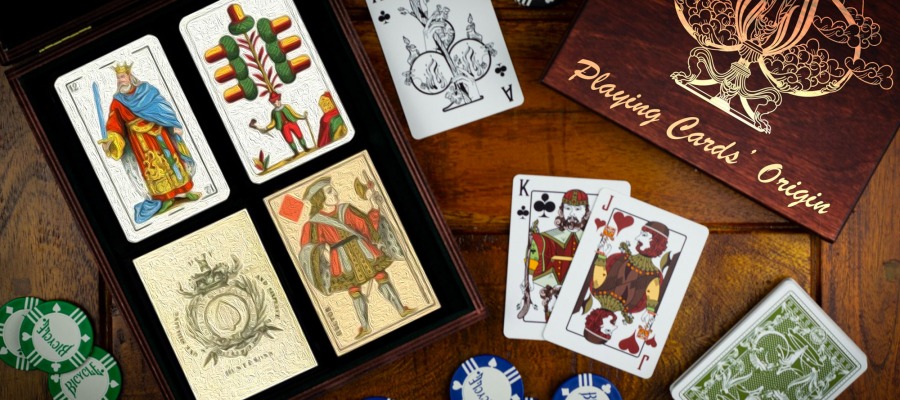The Mystery of the Playing Cards’ Origin

It is impossible to imagine any casino without playing cards because they are the main tool of many gambling games. The first cards appeared dozens of centuries ago, and have come a long way to acquire a modern look. It is not known exactly who and when invented playing cards. They had many prototypes, in particular wooden and stone tiles, pieces of leather with symbols painted on them, and so on.
Asia
East Asia is where playing cards initially appeared; during the Tang Dynasty, there are allusions to a game played using rectangular sheets in China. Later, it is said that Korea and Japan regularly played using oblong sheets. Masters and court aristocracy enjoyed creating miniature images of animals, birds, and plants as allegories in their spare time, which they later utilized to play risky games. In Korea, playing cards are imprinted with the images of eight different figures, including men, horses, antelopes, rabbits, pheasants, crows, fish, and stars. The deck included 80 cards, although there were 10 different cards for each of these figures.
The Chinese and Japanese utilized flat, oblong tablets made of wood, bamboo, or even ivory until paper maps were invented. Distinct cultures gave the cards various shapes and patterns. For instance, in India, circular cards known as Ganjifa were used for gaming. Indian artists portrayed the four-armed Shiva holding a glass, a sword, a coin, and a rod on the circular playing cards. By the way, these images eventually made their way onto tarot cards. Indian playing cards typically comprised four suits, but there were also 12 different colors, and each color contained 12 cards, for a total of 144 cards in the deck.
Europe
No reliable evidence exists to support how the cards got to Europe. The most likely route was from China via India to Egypt, followed by a direct route from Egypt to Europe. The history of playing cards in Europe dates back to the fourteenth century. These comments mostly concern the outlawing of card games in numerous European countries. But everyone in Europe was still playing cards by the middle of the 16th century.
There is a myth that the jester of the mad French king Charles VI invented the cards in a form remarkably similar to modern ones.
On cards with kings, queens, and jacks, several mythological and historical people were depicted. The old deck of cards was different from the modern deck in that it only included 32 cards. There weren’t enough four queens, therefore it wasn’t until the following century that Italian artists started painting Madonnas on playing cards.
Italian, French, and German playing cards are all produced at the same time. The suits on each of them as well as the characters themselves varied.
The creation of the card game “tarok” gave rise to the Italian style of cards. These cards, which resembled copper engravings, were really odd. The 78 cards in a standard, or “Venetian,” tarok were split into bowls, denarii, swords, and club suits. The king, queen, knight, jack, point cards from 10 to 6, the ace of swords, and point cards from 5 to 2 were among the 14 cards that made up each suit. The remaining 21 cards are known as trump cards or triumphs. There was one more card left, dubbed the Fool (the prototype of the Joker). In Florence, 98 pieces of cards were created, with the customary Triumphs joined by graces, elements, and 12 constellations.
The 56 regular cards plus the 22 “Major Arcana” and 20 additional trump cards with zodiac sign names made the early card games rather complicated. These cards had different names in different countries, and the instructions were so messed up that playing was just impossible.
The still-in-use French card suits of clubs, diamonds, worms, and spades are eventually established by the end of the 15th century.
The French deck provided the cards with a contemporary appearance. The jack, queen, king, and ace are the top cards in the deck, in accordance with the Parisian pattern. And it was in France that the concept of only having two colors for suits—red and black—was developed.
America
The most recent who learned the game of cards were the inhabitants of America. It became widespread when European settlers began to appear on the American continent. Native Americans (Indians) began to make decks depicting their national costumes. As for playing cards, the first who represented card games were the Spaniards. Despite the fact that they were the last who started playing cards, the Americans introduced the Joker into the card deck, which became the highest trump card. This was in the middle of the 19th century, card maker Samuel Hart reshuffled the American understanding of the card game by making the famous joker. The path of the fun joker in American card games began with Eucre (a popular card game common in America). For the Americans, the rules of the game were adapted to include trumps. The popularity of the Eucre continued to grow, and around the 1860s, players began to use blank cards, which they called “The Best Jack of Trumps.” It is believed that it was then that Samuel Hart introduced a new card. In 1863, he produced what is believed to be the first image of the “Best Jack of Trumps”, which he called the “Imperial Jack”.